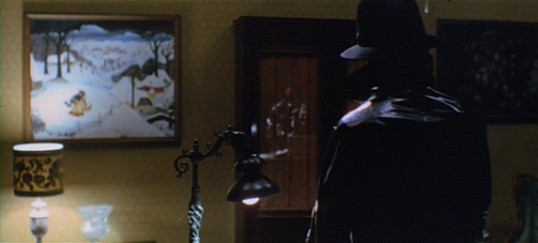(I’m using this year’s horrorthon as an excuse to watch and review all of the films of Dario Argento. Yesterday, I reviewed The Bird With The Crystal Plumage. Today, I take a look at The Cat o’Nine Tails.)
In 1971, Dario Argento followed up the massive success of The Bird With The Crystal Plumage with his second film as a director, The Cat o’Nine Tails. While The Cat o’Nine Tails was another huge financial success, it’s never been as a critically acclaimed as Argento’s first film. Argento, himself, regularly cites The Cat o’Nine Tails as being his least favorite of all of the films that he’s directed.
Much like The Bird With The Crystal Plumage, The Cat o’Nine Tails is a giallo that uses it’s rather complicated mystery as an excuse (a MacGuffin, to quote Hitchcock) for several suspenseful set pieces, the majority of which end with someone suffering some sort of terrible fate. In this case, a series of murders are taking place around a mysterious medical complex, the Terzi Institute. The murders are connected to some research being done at the institute. I’m not going to spoil things by revealing what exactly is being researched but I will say that the key to the mystery is vaguely ludicrous, even by the typically flamboyant standards of the giallo genre.
But, then again, so what? The fact that the genre’s mysteries are often overly complex and feature solutions that don’t always make sense is actually one of the appeals of the giallo film. You don’t really watch a giallo for the mystery. You watch it to see how the story will be told. Perhaps more than any other genre, giallo requires a director with a strong vision.
And, if nothing else, Argento has always had a strong directorial vision. Even when you may disagree with the choices that he makes (and I’m sure we all wonder why, in his later films, Argento grew so obsessed with telepathic insects), you can’t deny that they’re always uniquely Argento. Though the film never reaches the delirious heights of The Bird With The Crystal Plumage, The Cat o’Nine Tails still has several strong set pieces. There’s a sequence involving a poisoned glass of milk that I particularly appreciate. And then there’s the long scene at the crypt, in which our two protagonists realize that they don’t really trust each other all that much. And, of course, there’s the ending. For a film that’s often dismissed as being lesser Argento, The Cat o’Nine Tails features one of Argento’s darkest endings.
The Cat o’Nine Tails is unique as being one of the only Argento films to regularly show up on TCM. A lot of that is because The Cat o’Nine Tails is perhaps the least gory of all the films that Argento has made. That doesn’t mean that there isn’t plenty of death and mayhem. There is. Blood is spilled but it never exactly flows. The Cat o’Nine Tails is an Argento film that you could probably safely watch with an elderly relative. That’s not necessarily meant as a complaint. It’s just an observation that, when compared to the panty murder in The Bird With The Crystal Plumage or the skewering in The Mother of Tears, Cat o’Nine Tails is definitely a toned down Argento film.
The other reason why The Cat o’Nine Tails is popular on TCM is because it stars none other than that classic film mainstay, Karl Malden. Continuing the Argento tradition of featuring protagonists who aren’t sure what they’ve witnessed, Malden plays a former newspaper reporter who is now blind. He teams up with another reporter (played by James Franciscus, who may not have been a great actor but who did have perfect hair) to solve the murders. Franciscus has the eyes. Malden has the brains. And Malden’s niece, Lori (Cinzia De Carolis), is largely present to provide the film with its final ironic twist.
Malden does a pretty good job in the role, too. I’ve read some reviews that have complained that Malden overacts but actually, he gives the perfect performance for the material. In fact, Malden’s unapologetically hammy performance contrasts nicely with the work of James Franciscus, which could charitably be called subdued. (Perhaps a better description would be dull…)
Cat o’Nine Tails may not be Argento’s best but I still like it. If for no other reason, watch it for Malden and that wonderfully dark ending.

